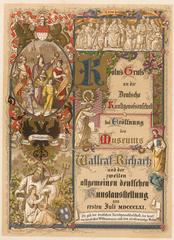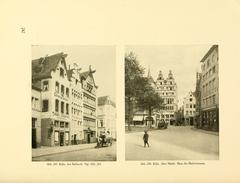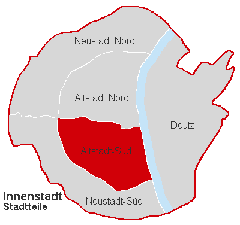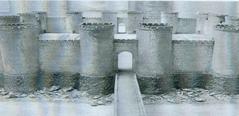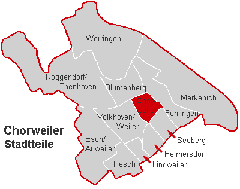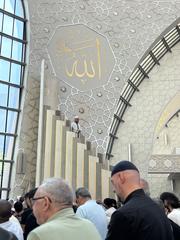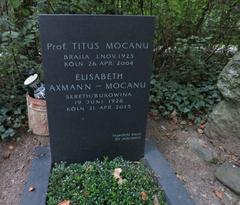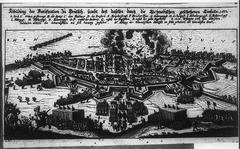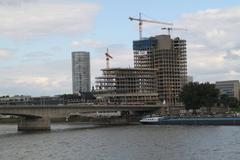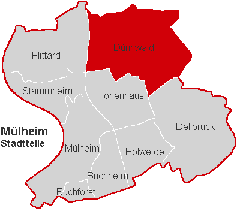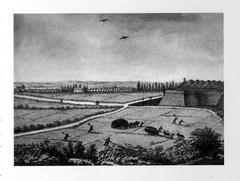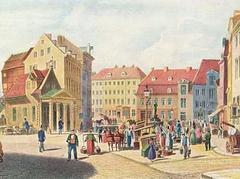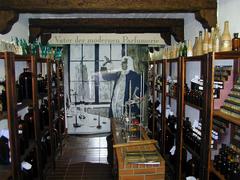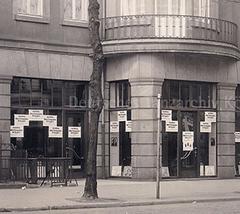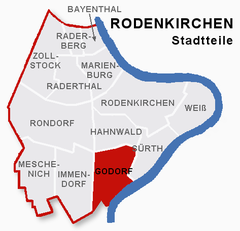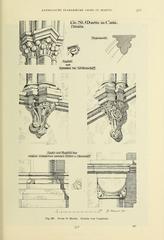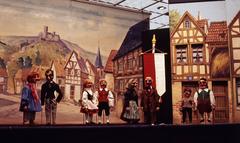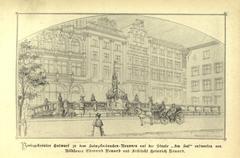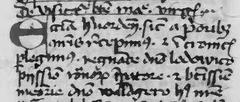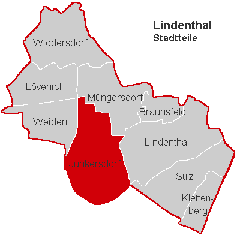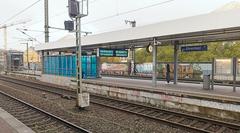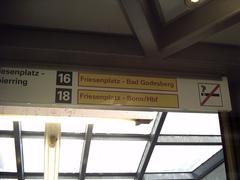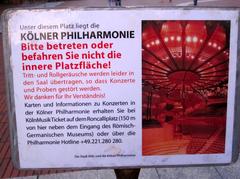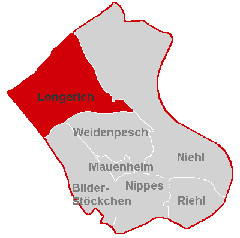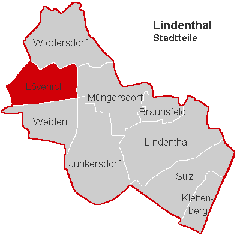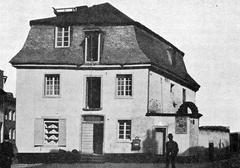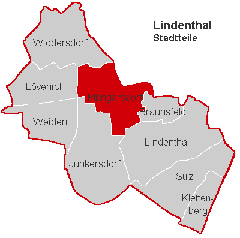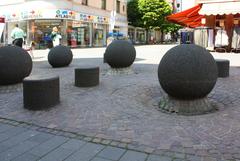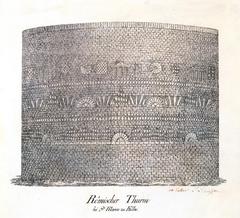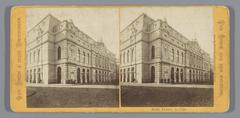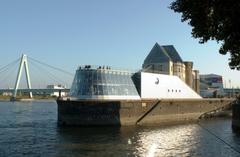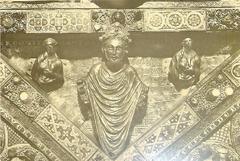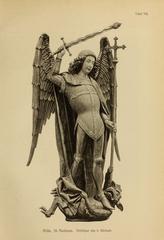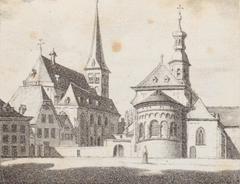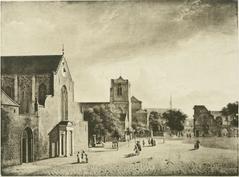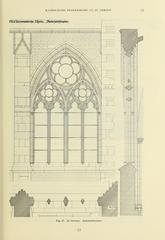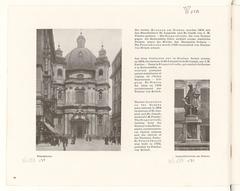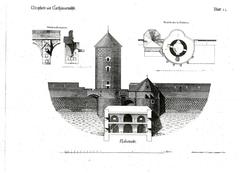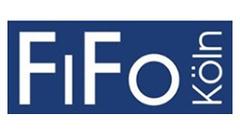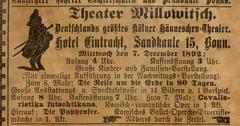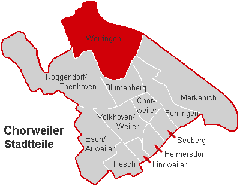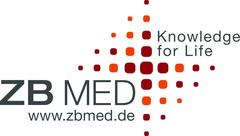
Wallraf-Richartz Museum: Visiting Hours, Tickets, and Visitor Tips
Date: 16/08/2024
Introduction
The Wallraf–Richartz Museum & Fondation Corboud is a cornerstone of Cologne’s cultural and artistic landscape. Located in the city’s historic center, the museum offers an extraordinary journey through European art, spanning from the medieval period to the 19th century. Founded on the bequests of Ferdinand Franz Wallraf and Johann Heinrich Richartz, the museum has survived war and change to become one of Germany’s leading art institutions. Its collection features masterpieces by artists such as Stefan Lochner, Rembrandt, Franz Hals, and, thanks to the Fondation Corboud, one of the country’s largest selections of Impressionist and Neo-Impressionist works (Wallraf-Richartz Museum History; Britannica). This guide covers the museum’s history, practical visitor details, travel tips, and highlights nearby attractions to help you make the most of your visit.
Table of Contents
- History of the Wallraf–Richartz Museum
- Visitor Experience and Facilities
- Practical Information
- Nearby Attractions and Travel Tips
- Dining, Shopping, and Photography
- FAQ
- Conclusion and Call to Action
- References
History of the Wallraf–Richartz Museum
Origins and Early Development
The museum’s foundation traces back to 1824, when Ferdinand Franz Wallraf, a passionate art collector and scholar, donated his immense collection to the city of Cologne. His legacy included not only paintings and sculptures but also drawings, rare manuscripts, books, coins, and artifacts—preserved from secularization and political upheaval (Wallraf-Richartz Museum History).
Establishment and Expansion
Initially, Wallraf’s collection was housed in temporary quarters until 1854, when merchant Johann Heinrich Richartz donated 100,000 thalers, enabling the construction of the museum’s first purpose-built facility. Designed by Josef Felten on the site of a former monastery, the museum opened its doors in 1861, shortly after Richartz’s passing. The institution continued to grow through further donations and, in 1946, acquired the Haubrich collection of contemporary art. In 1976, after a major donation from the Ludwigs, the 20th-century works were transferred to the newly established Museum Ludwig, allowing the Wallraf–Richartz Museum to focus on art from the medieval period to the 19th century (Wallraf-Richartz Museum History; Britannica).
Post-War Reconstruction and Modern Era
World War II brought devastation to the original museum building, but the collection was saved through timely evacuation. The post-war years were marked by reconstruction and renewal, culminating in a new building designed by Oswald Mathias Ungers, inaugurated in 2001. This modern, spacious structure, located near the heart of the old city, provides an ideal setting for the museum’s treasures and ongoing exhibitions (Wallraf-Richartz Museum History).
Fondation Corboud and Collection Highlights
A transformative moment came with the Fondation Corboud’s donation, which brought an extensive array of Impressionist and Neo-Impressionist works to the museum, including pieces by Monet, Manet, Renoir, van Gogh, Cézanne, and others. This made the Wallraf–Richartz Museum home to Germany’s most comprehensive collection of Impressionist art (Britannica).
Exhibitions and Cultural Impact
The museum has hosted numerous significant exhibitions, including highlights like Stefan Lochner’s “Madonna of the Rose Bower.” In 2024, a major exhibition titled “A Museum of Museums” will commemorate the 200th anniversary of Wallraf’s death, exploring the evolution of museum culture. The museum’s research library, opened in 1957 and now holding over 130,000 volumes, is an essential resource for scholars and enthusiasts alike (Wallraf-Richartz Museum History).
Visitor Experience and Facilities
The Wallraf–Richartz Museum is designed for an immersive and comfortable visitor experience. Its three main floors are organized chronologically:
- First Floor: Medieval Art
- Second Floor: Baroque Art and the Print Room (featuring master drawings by artists like Leonardo da Vinci and Albrecht Dürer)
- Third Floor: 19th-century Art, including Impressionism
The museum also offers a welcoming foyer, a well-stocked museum shop, and an excellent café—perfect for a break during your visit.
Practical Information
Opening Hours
- Tuesday – Sunday: 10:00 AM – 6:00 PM
- First and Third Thursday of Each Month: Open until 10:00 PM
- Closed: Mondays, Christmas Eve, Christmas Day, New Year’s Eve, New Year’s Day, and certain Carnival days (Wallraf Museum)
Ticket Prices
- Adults: €12
- Reduced (students, seniors): €8
- Children and youth under 18: Free
- Free Entry: On Cologne Day (first Thursday of the month, except holidays) for Cologne residents with ID (Wallraf Museum)
Guided Tours
Guided tours are available in several languages, covering themes from medieval painting to Impressionism. Tours start at €75 per group (up to 25 people); surcharges may apply for weekends, holidays, or foreign languages. Advance booking is recommended (Wallraf Museum).
Accessibility
The museum is fully accessible, with elevators and ramps for visitors with mobility impairments. Tactile models and audio guides are available for visually and hearing-impaired visitors. Assistance is available upon request. Guide dogs are permitted (Wallraf Museum).
Nearby Attractions and Travel Tips
Situated in Cologne’s old town, the museum is surrounded by:
- Cologne Cathedral (Kölner Dom): An iconic Gothic structure just 0.26 miles away (Lonely Planet).
- Roman-Germanic Museum: Focused on Roman history along the Rhine (Lonely Planet).
- Museum Ludwig: Renowned for modern art, including works by Picasso and Warhol (Travelsetu).
- Chocolate Museum: A popular destination for families (Travelsetu).
Travel Tips:
- Use public transportation (nearest stop: Heumarkt, served by tram lines 1, 7, and 9).
- Several parking garages are nearby, but spaces can be limited.
- Visit during spring or fall for pleasant weather and fewer crowds (Travelsetu).
Dining, Shopping, and Photography
- Café: Relax after your tour with a coffee or meal in the museum café.
- Museum Shop: Find art books, prints, and unique souvenirs.
- Photography: Non-flash photography is generally permitted, but restrictions may apply during special exhibitions. Please be considerate of other visitors and the artwork (Wallraf Museum).
FAQ
What are the Wallraf–Richartz Museum’s opening hours?
Tuesday to Sunday, 10:00 AM – 6:00 PM; extended hours to 10:00 PM on the first and third Thursday of each month. Closed Mondays and major holidays.
How much are tickets?
Adults: €12; Reduced: €8; Children under 18: Free. Cologne residents enjoy free entry on the first Thursday of the month.
Is the museum accessible?
Yes, with elevators, ramps, tactile models, and audio guides. Guide dogs are also welcome.
Are guided tours available?
Yes, in multiple languages; prices start at €75 per group. Book in advance for your preferred language and theme.
Conclusion and Call to Action
The Wallraf–Richartz Museum is a testament to Cologne’s enduring cultural legacy. Its world-class collection, modern facilities, and central location make it one of Germany’s premier art destinations. Whether you are an art lover, a history buff, or a curious traveler, the museum promises a memorable experience. Plan your visit today, and explore the artistic heritage the Wallraf–Richartz Museum so beautifully preserves.
For the latest updates, special exhibitions, and event information, visit the official museum website, follow the museum on social media, or download the Audiala mobile app for an enhanced visitor experience.
